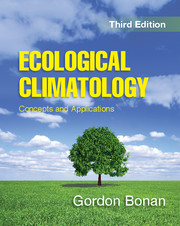Book contents
- Frontmatter
- Dedication
- Contents
- Preface
- 1 Ecosystems and Climate
- Part I The Earth System
- Part II Global Physical Climatology
- Part III Hydrometeorology
- Part IV Biometeorology
- Part V Terrestrial Plant Ecology
- Part VI Terrestrial Forcings and Feedbacks
- 25 Terrestrial Ecosystems and Earth System Models
- 26 Seasonal-to-Interannual Variability
- 27 Biogeophysical Climate–Vegetation Dynamics
- 28 Anthropogenic Land Use and Land-Cover Change
- 29 Carbon Cycle–Climate Feedbacks
- 30 Nitrogen, Chemistry, and Climate
- 31 Aerosols, Chemistry, and Climate
- 32 Urbanization
- 33 Climate Intervention and Geoengineering
- 34 Coevolution of Climate and Life
- Appendix
- Index
- Plate section
- References
31 - Aerosols, Chemistry, and Climate
from Part VI - Terrestrial Forcings and Feedbacks
Published online by Cambridge University Press: 05 November 2015
- Frontmatter
- Dedication
- Contents
- Preface
- 1 Ecosystems and Climate
- Part I The Earth System
- Part II Global Physical Climatology
- Part III Hydrometeorology
- Part IV Biometeorology
- Part V Terrestrial Plant Ecology
- Part VI Terrestrial Forcings and Feedbacks
- 25 Terrestrial Ecosystems and Earth System Models
- 26 Seasonal-to-Interannual Variability
- 27 Biogeophysical Climate–Vegetation Dynamics
- 28 Anthropogenic Land Use and Land-Cover Change
- 29 Carbon Cycle–Climate Feedbacks
- 30 Nitrogen, Chemistry, and Climate
- 31 Aerosols, Chemistry, and Climate
- 32 Urbanization
- 33 Climate Intervention and Geoengineering
- 34 Coevolution of Climate and Life
- Appendix
- Index
- Plate section
- References
Summary
Chapter Summary
Aerosols affect the radiative balance of the atmosphere by absorbing and scattering radiation, by altering cloud albedo, and through precipitation. Their primary radiative effect is to increase planetary albedo, and aerosols have a negative radiative forcing. However, black carbon (commonly called soot) is an absorbing aerosol that heats the atmosphere, and deposition on snow and ice decreases surface albedo (a positive radiative forcing). Aerosols also have indirect effects by altering biogeochemical cycles. Mineral aerosols affect climate directly by altering the radiative balance of the atmosphere and indirectly by fertilizing ecosystems. Dust emissions may initiate a positive land–atmosphere feedback that enhances drought. Fires influence climate through emissions of long-lived greenhouse gases, organic and black carbon aerosols, and short-lived reactive gases. These latter emissions produce ozone, alter the oxidation capacity of the troposphere through the hydroxyl (OH) radical, and thereby affect the concentration of methane (CH4). The net radiative forcing of fires is the balance of these biogeochemical emissions and also biogeophysical effects from changes in surface albedo and energy fluxes. It is estimated the fires provide a negative radiative forcing. They may also decrease precipitation in a positive feedback whereby biomass burning promotes drought and greater susceptibility to fire. Plants emit numerous biogenic volatile organic compounds (BVOCs). Oxidation of these BVOCs in the presence of nitrogen oxides (NOx) forms ozone. Emissions of BVOCs also reduce the oxidation capacity of the atmosphere (OH), decreasing the atmospheric sink for CH4 and increasing its lifetime in the atmosphere. Chemical transformations also produce secondary organic aerosols. Emissions of BVOCs are thought to provide a negative radiative forcing, but this is likely to diminish in the future because of human activities. Chemistry–climate interactions from short-lived climate forcers (NOx, BVOCs, ozone, CH4, and secondary organic aerosols) are now recognized as being significant and comparable in magnitude to other climate forcings. The aerosol effects of dust, fire, and BVOCs, as well as their chemistry–climate interactions, are important feedbacks with climate change.
- Type
- Chapter
- Information
- Ecological ClimatologyConcepts and Applications, pp. 606 - 627Publisher: Cambridge University PressPrint publication year: 2015



